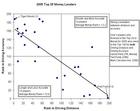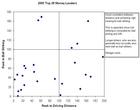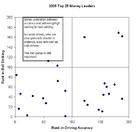Flogging: It Works For Tiger
/On Mike Vitti's PGATour.com ShotLink blog (scroll down to find the post), he breaks down an interesting new "percentage-of-distance-covered-by" stat that validates the flogging approach, at least for Tiger Woods.
So, for example, if a player hits a 300-yard drive on a hole measuring 450 yards the percentage of drive covered is 300 yards/450 yards or 66.7 percent. The 2006 TOUR average for this statistic is 61.7 percent for all driving holes. On par 4s the percentage rises to 65.6 percent, while on par 5s it drops to 52.1 percent.
He brings the stat up to look at Tiger possibly using driver less often:
Judging by his results at Royal Liverpool, it appears that Woods should do whatever he can to find the fairway, and not worry about distance. However using the distance covered percentage on par 4s as the counter to this argument, accuracy in lieu of distance may not be Woods' best option. Consider the following from par-4 statistics by Tiger Woods:
2005-2006 Tiger Woods Par-4 Scoring
Drive Covers at least 67% of Hole Yardage Drive Less than 67% of Yardage
Total Drives 465 341
Under Par 130 (28.0%) 47 (13.8%)
Over Par 45 (9.7%) 62 (18.2%)
In 2005-2006, Woods had 465 drives on par 4s where he covered at least 67 percent of the distance of the hole from off the tee. In these instances, he was able to make birdie or better 28 percent of the time. On the drives where Woods did not reach this mark, he only made birdie or better 18.2 percent of the time, and he also had a higher rate of over-par scores in these situations.
Then he looks at drives landing in fairway v. rough.
2005-2006 Tiger Woods Par-4 Scoring
Drive Covering at least 67%, Out of the Fairway Drive Less than 67%, In Fairway
Total Drives 211 193
Under Par 41(19.4%) 36(18.7%)
Over Par 30 (14.2%) 16 (8.3%)
2005-2006 Tiger Woods Par-4 Scoring
Drive Covering at least 67%, In the Fairway Drive Less than 67%, Out of Fairway
Total Drives 254 148
Under Par 89 (35.0%) 11 (7.4%)
Over Par 15 (5.9%) 46 (31.1%)
The conclusion:
Out of the rough on longer drives Woods has about as good a chance of making birdie as he does from the fairway on shorter ones, and more importantly, if he misses the fairway on a shorter drive he has a much greater chance of making bogey. If you are thinking that his accuracy with the shorter club should be greater than with the longer one, look at the numbers again. Woods' accuracy on drives that travel at least 67 percent of the fairway is around 55 percent while the accuracy rate for drives less than 67 percent is only around 43 percent. So why bring a greater risk of bogey into play if you can avoid it?
So Vitti concludes:
Back to the original argument, on whether Woods should change his strategy, I would say yes - every time he plays Royal Liverpool or a course that dictates that would be the best way to win. Otherwise, I think with 49 career victories, including 11 majors, Woods already knows what approach is best for him.























